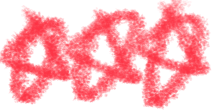tab을 두번 누르면 위의 백틱(`)을 사용한 것과 같습니다. <span style="color:red">빨간 글씨</span> <span style="color:blue">파란 글씨</span> <span style="color:green">초록 글씨</span> <span style="color:yellow">노란 글씨</span> <span style="color:purple">보라 글씨</span>
이 블로그의 닉네임은?
poeun. 열린상태로 보여준다.
블로그를 더욱 알고 싶다면?
github.com/ingu627 로 이동한다.
각주 : 1
미주 : 1에 대한 내용
미주는 글 뒷 부분에 삽입합니다.
취소선
텍스트 뒤에 space bar를 두번 치고 enter를 누른 뒤 다음 텍스트를 씁니다.
다음
다음
다음
다음
😁
이것은 ==하이라이트== 입니다.
이 태그는 H2O를 표현할 수 있습니다.
일단 실천하라. 그러면 힘을 지니게 될 것이다.
-왈도 에머슨-
- 설명
- 이해시키는 것을 목적으로 하는 진술 방법
©
Watch out! Text~
Watch out! Text~
Watch out! Text~
Watch out! Text~
Watch out! Text~
Watch out! Text~
빨간 글씨
파란 글씨
초록 글씨
노란 글씨
보라 글씨
빨간 글씨
파란 글씨
초록 글씨
노란 글씨
보라 글씨
글자는 흰색, 배경은 빨강, 사이즈는 150, 굵기는 b태그로 설정

탭2번
이 태그는 H
2O를 표현할 수 있습니다
이 태그는 2
2를 표현할수 있습니다.
이것은 ==하이라이트== 입니다.
sequenceDiagram A-->B: Works!
```mermaid
sequenceDiagram
A-->B: Workwows!
```
flowchart TB
c1-->a2
subgraph one
a1-->a2
end
subgraph two
b1-->b2
end
subgraph three
c1-->c2
c3-->a2
c4-->a2
end
Mermaid graph diagram:
graph TD
A[Client] --> B[Load Balancer]
B --> C[Server1]
B --> D[Server2]
|
graph TD
A[Client] --> B[Load Balancer]
B --> C[Server1]
B --> D[Server2]
|
graph TD
A[Client] -->|tcp_123| B
B(Load Balancer)
B -->|tcp_456| C[Server1]
B -->|tcp_456| D[Server2]
|
graph TD
A[Client] -->|tcp_123| B
B(Load Balancer)
B -->|tcp_456| C[Server1]
B -->|tcp_456| D[Server2]
|
Basic flowchart
graph LR
A[Square Rect] -- Link text --> B((Circle))
A --> C(Round Rect)
B --> D{Rhombus}
C --> D
|
graph LR
A[Square Rect] -- Link text --> B((Circle))
A --> C(Round Rect)
B --> D{Rhombus}
C --> D
|
Basic flowchart 2
graph TB
A[Square Rect] -- Link text --> B{Rhombus}
B -->C
B --> D{Rhombus}
D --> E
D --> F
D --> G
|
graph TB
A[Square Rect] -- Link text --> B{Rhombus}
B -->C
B --> D{Rhombus}
D --> E
D --> F
D --> G
|
Timeline Example
timeline
title History of Social Media Platform
2002 : LinkedIn
2004 : Facebook
: Google
2005 : Youtube
2006 : Twitter
|
timeline
title History of Social Media Platform
2002 : LinkedIn
2004 : Facebook
: Google
2005 : Youtube
2006 : Twitter
|
Pie chart:
pie title NETFLIX
"Time spent looking for movie" : 90
"Time spent watching it" : 10
|
pie title NETFLIX
"Time spent looking for movie" : 90
"Time spent watching it" : 10
|
Mindmap Diagram
mindmap
root((mindmap))
Origins
Long history
::icon(fa fa-book)
Popularisation
British popular psychology author Tony Buzan
Research
On effectiveness
and features
On Automatic creation
Uses
Creative techniques
Strategic planning
Argument mapping
Tools
Pen and paper
Mermaid
|
mindmap
root((mindmap))
Origins
Long history
::icon(fa fa-book)
Popularisation
British popular psychology author Tony Buzan
Research
On effectiveness
and features
On Automatic creation
Uses
Creative techniques
Strategic planning
Argument mapping
Tools
Pen and paper
Mermaid
|
Requirement Diagram
requirement test_req {
id: 1
text: the test text.
risk: high
verifymethod: test
}
element test_entity {
type: simulation
}
test_entity - satisfies -> test_req
|
requirementDiagram
requirement test_req {
id: 1
text: the test text.
risk: high
verifymethod: test
}
element test_entity {
type: simulation
}
test_entity - satisfies -> test_req
|
Complete flowchart
Left to right(LR) graph orientation :
(options:
TB - top to bottom
TD - top-down/ same as top to bottom
BT - bottom to top
RL - right to left
LR - left to right )
graph LR
A[Square Rect] -- Link text --> B((Circle))
A --> C(Round Rect)
B --> D{Rhombus}
C["`**Markdown** string`"] --> D
E -->F([Stadium-shaped node]}
id1[[This is subroutine shape]]
id2[(Database)]
id3((This is the text in the circle))
id4 >asymmetric shape]
id5{decision}
id6
id7[/Parallelogram/]
id8(((Double circle)))
F-.->dottedLink;
G-.dotted link with text .->H
H == thick link ==> I
J -- text --> K -- chaining link --> L
M --o N
N --x O
O x--x P
|
graph LR
A[Square Rect] -- Link text --> B((Circle))
A --> C(Round Rect)
B --> D{Rhombus}
C --> E["`**Markdown** string`"]
E -->F([Stadium-shaped node])
id1[[This is subroutine shape]]
id2[(Database)]
id3((This is the text in the circle))
id4>asymmetric shape]
id5{decision}
id6
id7[/Parallelogram/]
id8(((Double circle)))
F-.->dottedLink;
G-.dotted link with text .->H
H == thick link ==> I
J -- text --> K -- chaining link --> L
M --o N
N --x O
O x--x P
|
real flowchart
flowchart TD
A[Start] --> B{Is it?}
B -->|Yes| C[OK]
C --> D[Rethink]
D --> B
B ---->|No| E[End]
|
flowchart TD
%% this is a comment : TD means top down orientation of the chart
A[Start] --> B{Is it?}
B -->|Yes| C[OK]
C --> D[Rethink]
D --> B
B ---->|No| E[End]
|
Styling
flowchart LR
id1(Start)-->id2(Stop)
style id1 fill:#f9f,stroke:#333,stroke-width:4px
style id2 fill:#bbf,stroke:#f66,stroke-width:2px,color:#fff,stroke-dasharray: 5 5
flowchart LR
id1(Start)-->id2(Stop)
style id1 fill:#f9f,stroke:#333,stroke-width:4px
style id2 fill:#bbf,stroke:#f66,stroke-width:2px,color:#fff,stroke-dasharray: 5 5
|
Applying CSS classes
code:
flowchart LR
A-->B[AAABBB]
B-->D
class A cssClass
%%{init: {"flowchart": {"defaultRenderer": "elk"}} }%%
flowchart LR
A-->B[AAABBB]
B-->D
class A mycssClass
|
Markdown not work
``` mermaid
flowchart LR
Start --> Stop
```
~~~
flowchart LR
id1[This is the text in the box]
~~~
~~~ mermaid
flowchart LR
Start --> Stop
flowchart LR
id1[This is the text in the box]
~~~
-->

Comments